The fantastical Phuket Botanic Gardens
And some unpleasant memories of being a gardener in Morecambe
It was a one-night flying visit to Phuket, but I did manage to spend a couple of hours at Phuket Botanical Gardens. These are located on the outskirts of the town in the midst of what appeared to be an industrial estate. I bought a ticket from a woman hanging around outside (the ‘Foreigner Price’ is not particularly cheap at 500 Baht, over £12.00) and then she led me round to the wooden doors which have an impressively ornate surround. She ceremonially unlocked them and gestured me in, first insisting that she take my photo. As she left and locked the doors behind me I felt like I was entering the world of Narnia and I wondered if I would ever get out.
The ornate entrance to Phuket Botanical Garden
It did feel fantastical partly because the plants were so large and lush against the surrounding treeless environment, and also because there were various bizarre objects everywhere; totem poles, wooden reliefs, a whole range of Buddhist shrines, and strange grinning doll-like sculptures. To top it all, piping out from the tree tops, was some weird, tinkling music which all added to the feeling of otherworldliness. .
Cloud Tree in the Japanese Garden
I had asked the woman who let me in for a map but she said that I didn’t need one. And indeed there were plenty of signs to all the different areas: the Vine Garden, Lotus Garden, Tropical Rain Forest Garden, Palm Garden, Japanese Garden, Orchid Garden, Fragrant Garden, and Cactus Garden and the Variegated Leaf Garden (a new one on me). I later realised there were at least 30 different sections and I ambled in and out of them without trying to make a mental map of the place. Some of the plants were so magnificent, such as this Platycerium bifurcatum below, that I just enjoyed following my nose. There was no one else there; no visitors and no gardeners that I saw.
Platycerium bifurcatum(Stag’s Horn Fern)
I had done some research about the botanic gardens of Thailand so I knew that Phuket was not one of the five that are all affiliated to the Botanical Garden Organisation, maintained by the Ministry of Natural Resources and Environment, and which have official research and collection functions. Moreover, plants in “proper” botanic gardens are usually formally labelled with Family, Genus, Species, Country of Origin, etc. The Phuket garden appeared to be a private enterprise and I had read somewhere that it was “probably the creation of an enthusiast.” Nothing useful could be found on the web. However, the fact that the plants are organised in family groups and that some of the trees were labelled was a real bonus.
My companion and a wooden relief
A ginger cat with a stubby tail was my only companion; he relentlessly weaved himself in and out of my legs and more than once I very nearly tripped over him. He abandoned me when I went into the fabulous Rain Forest Garden where you cross little bridges over streams and walk through vines and lianas under a refreshing waterfall.
The Rainforest Garden
The door to the Palm Garden
Another highly decorative door led into The Palm Garden. I loved the magnificent Traveller’s Palm (Ravenala madagascariensis) which are common in Thailand although obviously native to Madagascar. They are not actually true ‘palms’ but a member of the Strelitzia family, which includes the well known Bird of Paradise Flower. The common name of this tree is derived from the fact that the sheaths of the stems hold rainwater and so are a handy water supply for travellers.
Ravenala madagascariensis (The Traveller’s Palm)
‘Real’ palms included Elaeis guineensis (African Oil Palm), Dolichandrone serrulate (Fan Palm), Phoenix Hancean nandinfan (Taiwanese Date Palm) and Normanbya normanbyi which I thought at first was Wodyetia bifurcata (the Foxtail Palm) as it had that bushy foxtail-like fronds. But I learned later that Normanbya is a threatened Australian species, endemic to Queensland, (it grows nowhere else naturally) and it is monotypic, meaning that there are no other species in this genus. So it was good to see that doing well in Phuket.
Normanbya normanbyi (Black Palm)
I have seen the very similar-looking true Fox Tail Palms everywhere in Thailand; they are frequently used for roadside planting, probably because they ‘self-clean’; the old fronds fall off the tree by themselves so it doesn’t have to be pruned of dead material. I have also seen them along sea fronts here which will be because they tolerate high levels of salt.
The Orchid Garden and the Cacti Garden were amazingly colourful. I still cannot quite get over being somewhere where plants that I am used to seeing in glasshouses, and which are often struggling in there, are thriving outside here. No doubt it will soon become normal.
Opuntia in Trousers
Of the objects and sculptures dotted around, there were some lovely carvings and interesting stone features, but these were interspersed with giant crocodile heads and enormous plastic plants amongst the real ones, which seemed unnecessary as the real plants are sufficiently spectacular.
Bromeliads in a Boat
Plastic plants
I started to feel a little odd here, which seems to be happening when I haven’t seen anyone for a while and am surrounded by plants, or it could be just the relentless heat.
Shrines?
The chiming music was getting quite irritating too; just as I thought that I was moving away from it, I would turn a corner and it would be even louder. It was probably supposed to be relaxing but it was having the opposite effect on me. I was reminded of the worst gardening job I had done, indeed probably the worst job I have ever done, which was when I was briefly living in Morecambe and working for the council in the very hot summer of 1994.
For the first couple of months I had been mainly mowing and strimming bowling greens, parks, cemeteries, road-side banks and roundabouts, in fact anywhere where there was grass. Now it is a relief to see so many of these verges etc covered in wild flowers and mixed grasses which don’t require frequent attention, and, apart from the benefits to the environment, and the fact that they look much prettier, it will be a relief to Council gardeners not to have to mow them. The steep grass banks were the worst; it involved having a fly-mower attached to you by a rope round your waist so that you wouldn’t drop it into the traffic below, and then standing at the top of the slope hauling it up, shifting along, and letting it down again. On occasion I just could not pull the mower up without help.
Then there was the strimming round trees and under hedges; this was before people bagged up dog poo. I once got a face full of it, (we only had goggles then and not full face masks, but fortunately my colleagues had warned me to keep my mouth shut when strimming for this very reason. One of the gardeners got frog parts all over his face one day. I am not sure what’s worse; at least I hadn’t killed a poor frog. There were plenty of anecdotes about even more dreadful strimming splatterings, which I won’t share here. The cemeteries were my favourite as they were often old, overgrown, beautiful, shady places, tucked away where no one ever went, and no dog-walkers. Although you had to be careful there too and I frequently sent urns and various burial containers flying across the graves when the strimmer got too close.
I was the only woman on the team of 50 gardeners. Indeed I was the only woman at the council depot each morning, where all the bin men, road sweepers, motorway workers etc gathered before dispersing in their various vehicles out and about round Lancaster and Morecambe. It was a bit odd being me, but the men were friendly and and I didn’t experience any problems. Not that I didn’t witness any sexual harassment from some of them to women on the street as we drove around in the van. When I remonstrated, they would apologise and say, sorry I forgot that you weren’t one of us! Clearly it happened much more when I wasn’t with them.
So it was with some relief one day when I was told that rather than having to drive hither and thither and mow and strim, I would be “permanently” moved to Happy Mount Park, a small traditional park at the far end of Morecambe prom. It was just me and old Colin, who had worked there for hundreds of years. Every morning he greeted me with a sigh and would say: “Eh, I feel right weary today.” Then he would go on to talk about the latest model of horticultural machinery that he had seen somewhere, a rotavator or a drive-on mower: “We didn’t need that in my day…. In my day…. ” The only thing that Colin and me really had in common was that we both hated Noel Edmonds, and we spent a great deal of time slagging him off. Our job involved destroying areas of the park’s lovely Woodland Walk so that contractors could come and plonk ugly, spotty, pink and white, fibreglass houses with painted windows and doors, in amongst the little copses of trees.
The worst was yet to come; a few weeks later ‘The World of Crinkly Bottom’ opened and not only was the peace shattered by over-excited small children and tired parents, but we were subjected to piped music blasting from speakers placed all around the park. There were only two songs and they were played almost continuously: “Blobby, Mr Blobby. Bla, Bla-Bla, bla bla.” It was absolutely torturous. In fact I am sure I have read that such a thing was a form of torture in Guantanamo Bay. Compared to the mowing, the job would have been quite easy if it weren’t for that relentless dreadful soundtrack; I was mainly doing light work such as weeding, deadheading roses and staking Dahlias.
But I didn’t get the brunt of it. There were two Mr Blobbys and they had to do shifts, sharing the same suit, which apparently never got washed. They both bitterly complained to me how the other person sweated so much that the suit absolutely stank by the time it was their shift. In fact everyone was complaining; the parents about the expense; the children that there was nothing to do and that they couldn’t get inside the painted cottages; and us gardeners about everything else. The children had to find Mr Blobby and watch him do his exercises and hang out washing, by which time everyone was so fed up, that he had to endure insults, swearing and on occasion have things thrown at him. Often the parents started complaining to me that they wanted their money back, as if I had anything to do with it. I was just doing a summer job, thinking to save up and go travelling, although that never happened, (until 28 years later) as I got pregnant instead. The worst thing was that even when I was not at work, the songs would be going round and round in my head.
One particularly sweltering day, the music suddenly stopped and a voice came over the tannoy: “Mr Blobby, where are you? Mr Blobby, can you come out from where-ever you are.” This had never happened before. He kept repeating the request, getting more high-pitched and increasingly hysterical. The park almost seemed to stand still. The Mr Blobby on shift had disappeared. It later emerged that he had just done a runner; clearly the insults had eventually got to him. He never returned. I left very shortly after.
I subsequently heard that when Noel Edmonds tried to visit Morecambe, he was chased off by the locals, (this disastrous nightmare had cost taxpayers £2 million as well as destroying their park); he had had to make a run for it and got whisked away by his helicopter only seconds before the crowd tore him to pieces. Fortunately Blobbygate was all over within weeks and Happy Mount Park reverted to it’s normal peaceful state.
Gardener’s cottage
Anyway, walking around Phuket Botanical Garden with this annoying music had bought all that back to me. No wonder there were no gardeners to be seen. A little hut with a kitchen, a bed and old gardening tools was interesting. Although I couldn’t be sure whether or not this was an exhibit; the blanket on the bed looked quite fresh.
Tillandsia hair
Signs to the exit took me past ochre walls covered with Tillandsia and mosses. And when I think about the garden since, it is the bright and gaudy colours that have stuck with me. Although the garden shop on the way out was the antithesis of cheery; dimly lit and full of old dusty cabinets stuffed with junk and nothing plant-related. Again, all slightly odd. Unfortunately there was no cafe either. But it was a very memorable garden. And once more I left with that feeling that I was returning to reality after a brief sojourn into the uncanny world of plants.
Phuket Botanical Garden shop






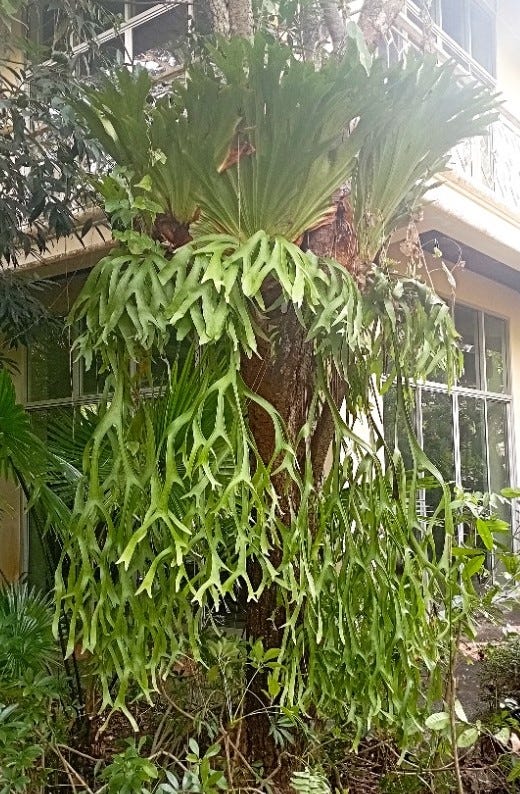
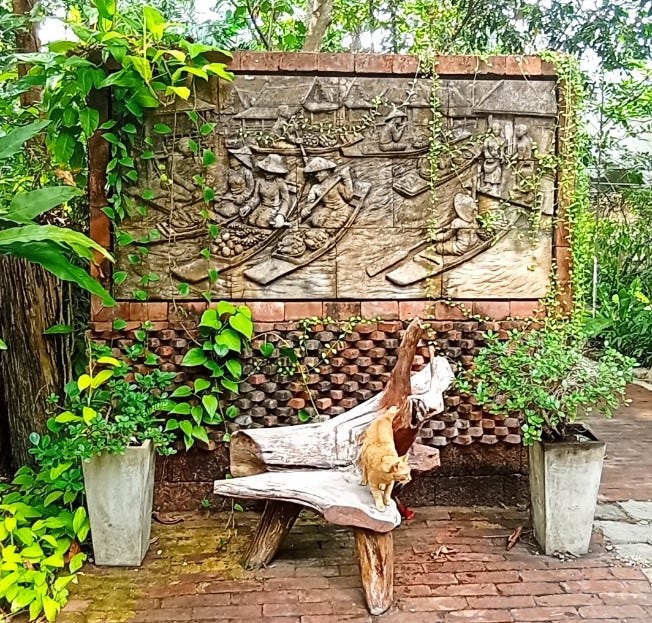

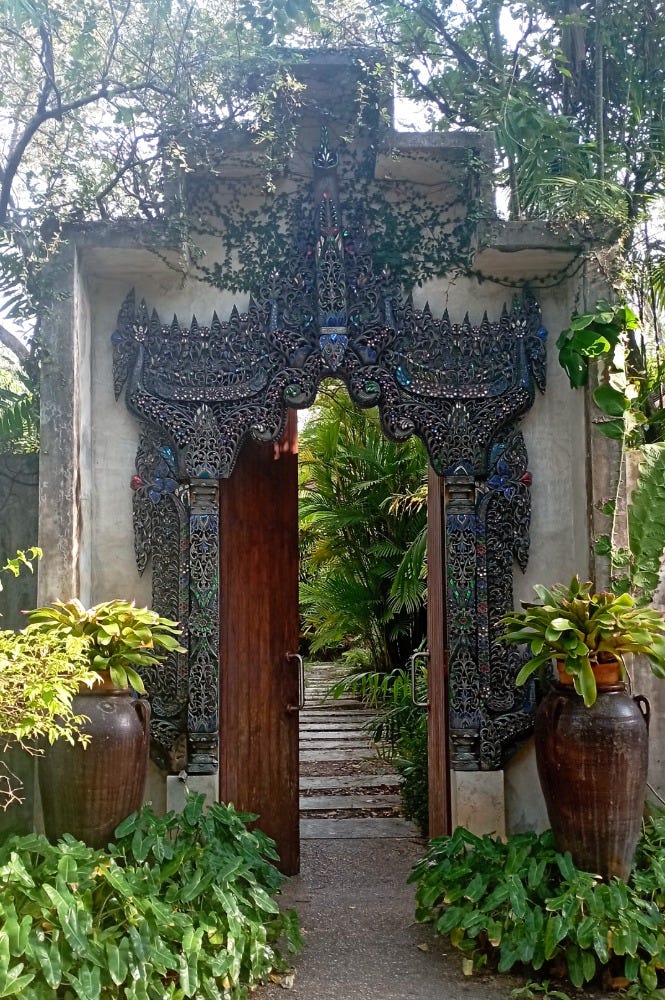

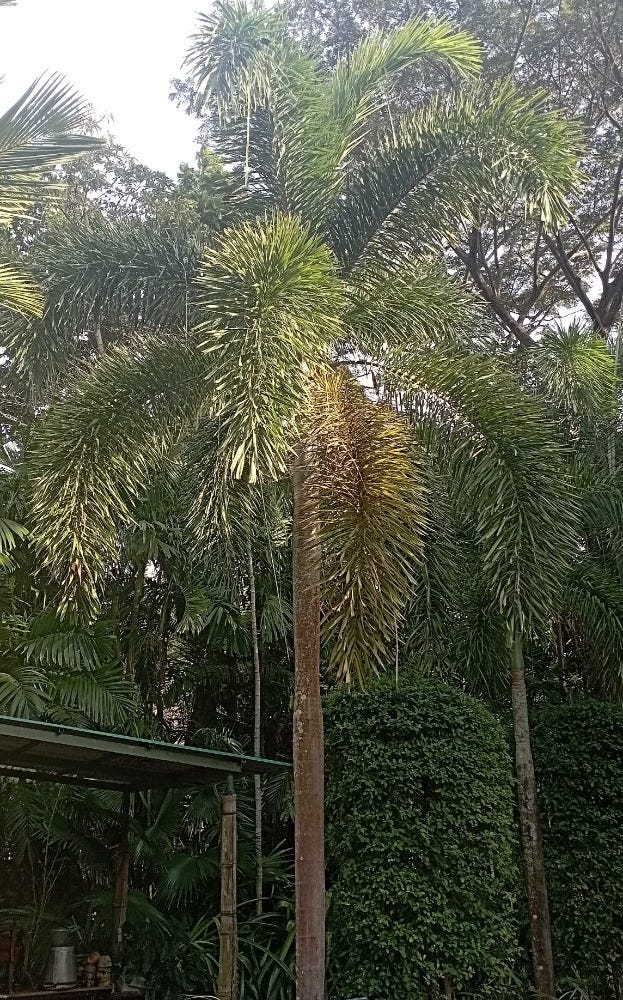
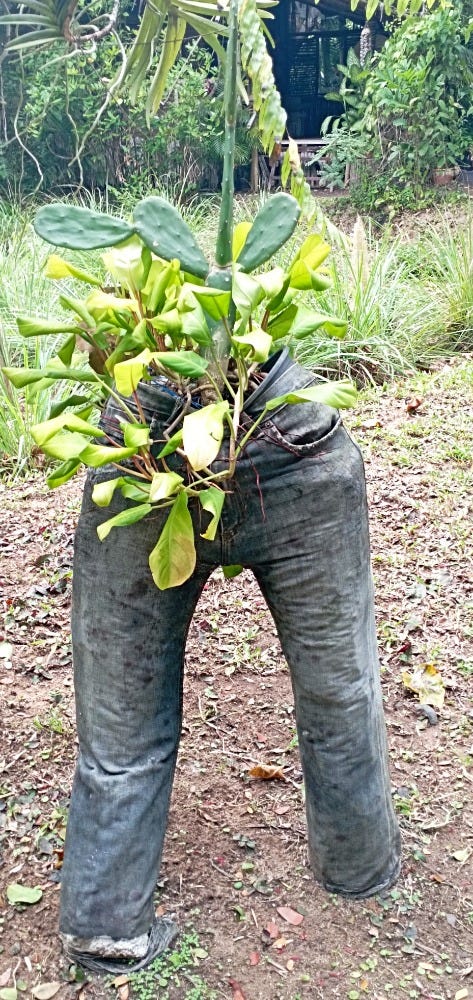
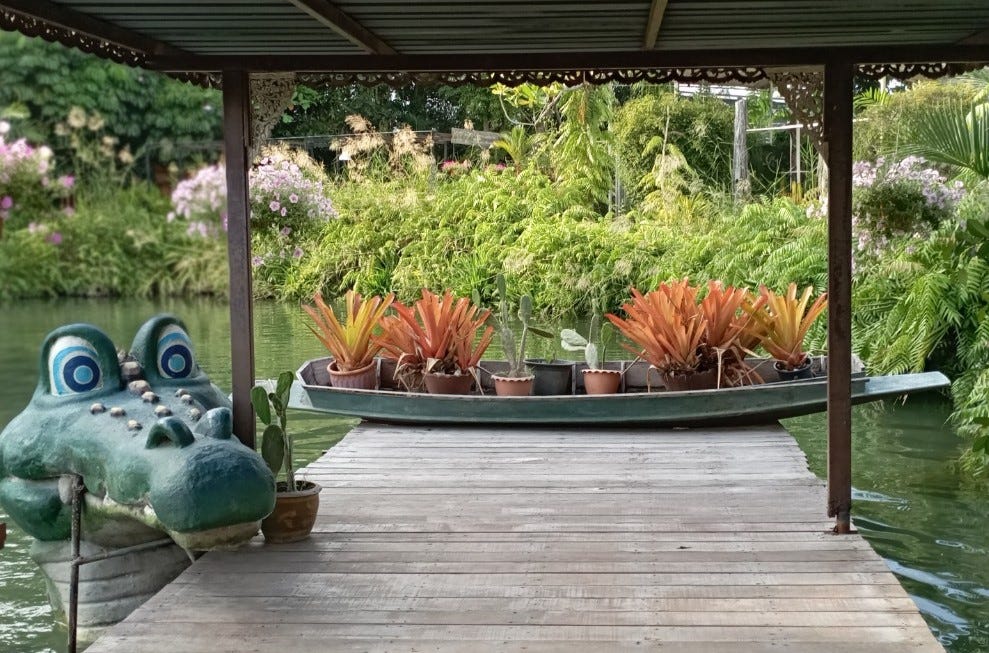
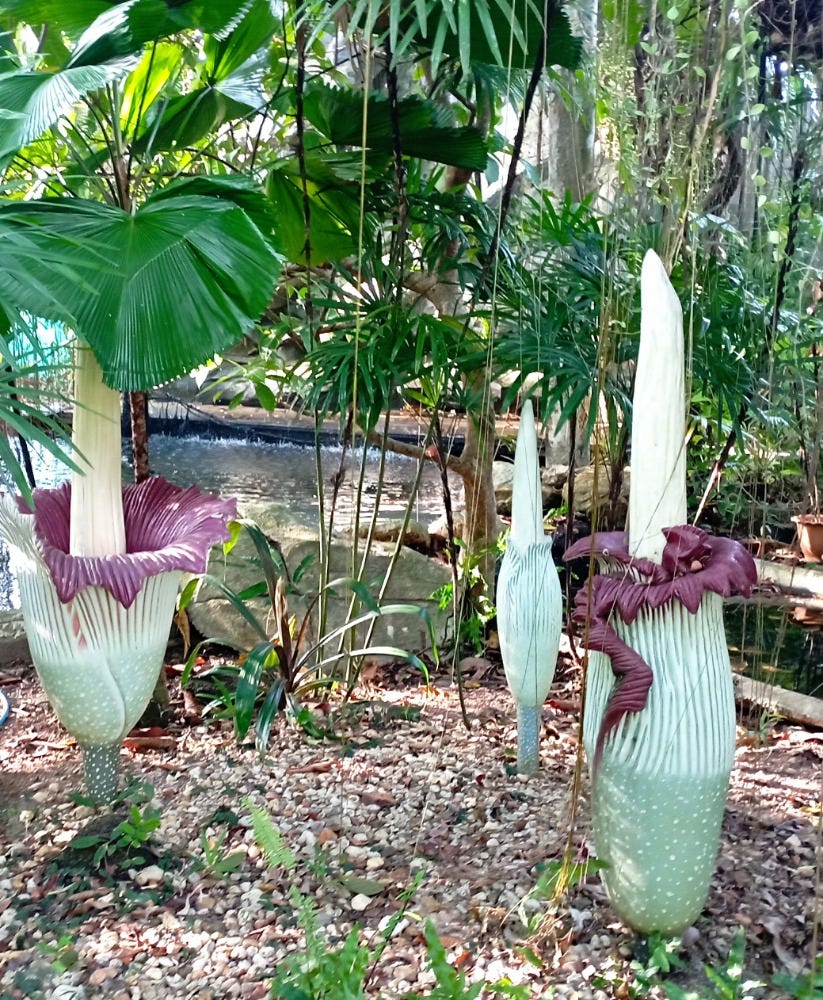
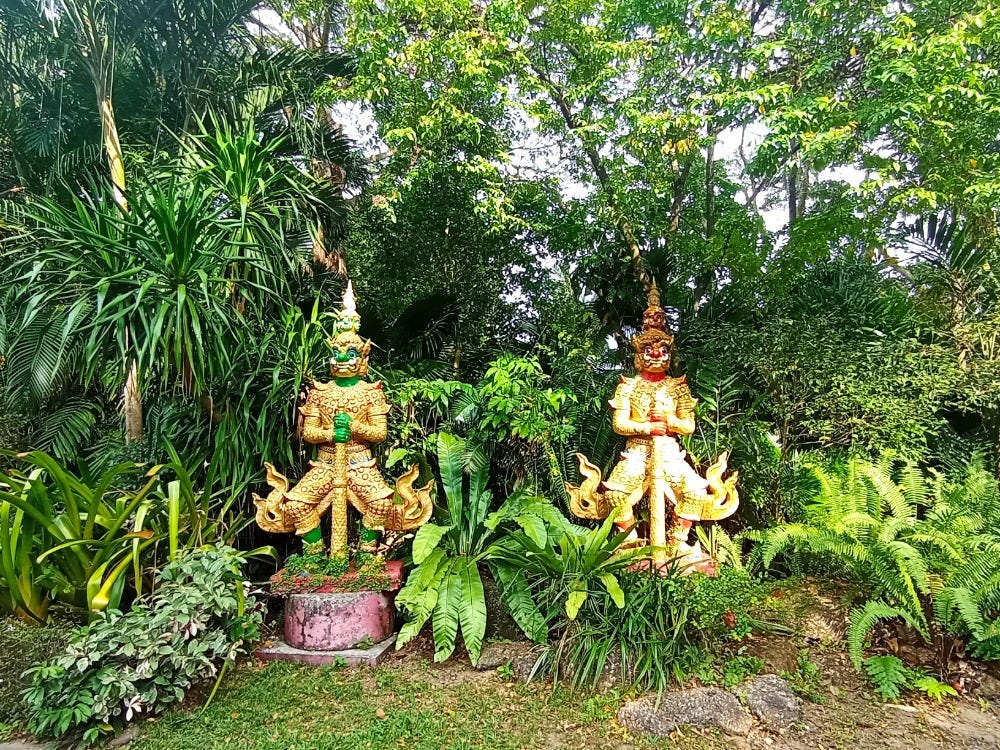
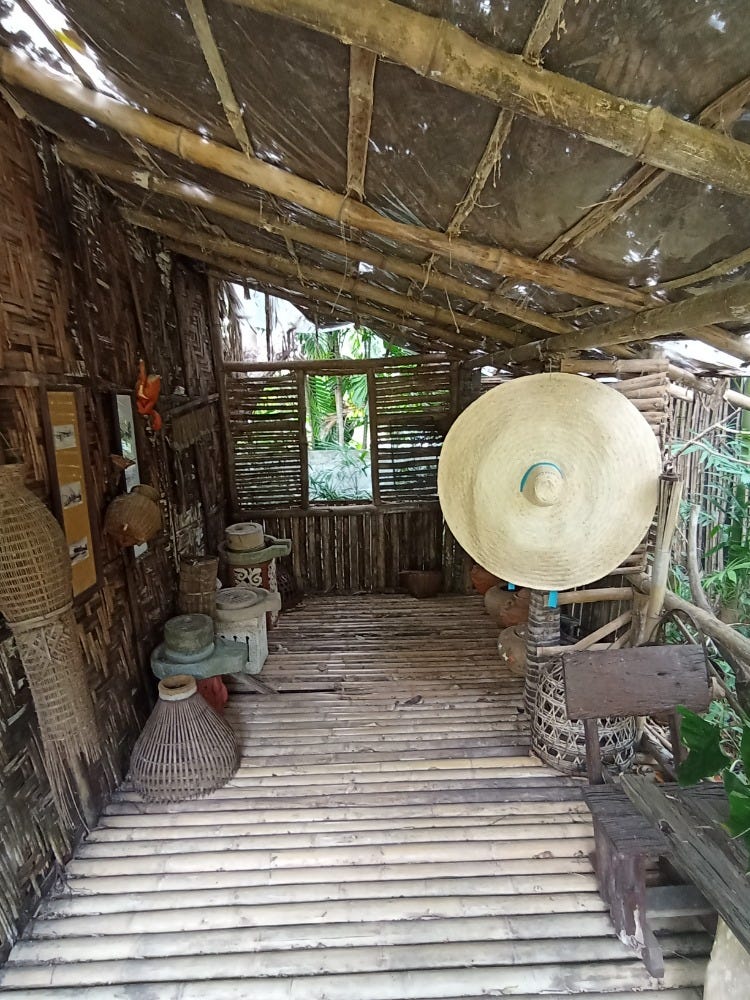
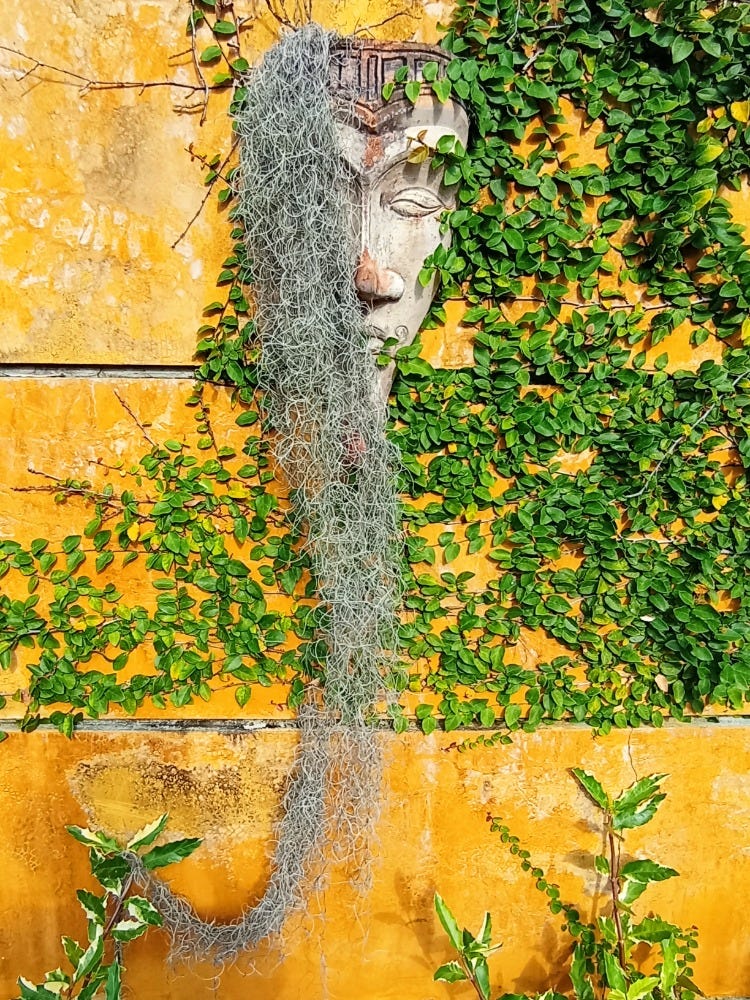
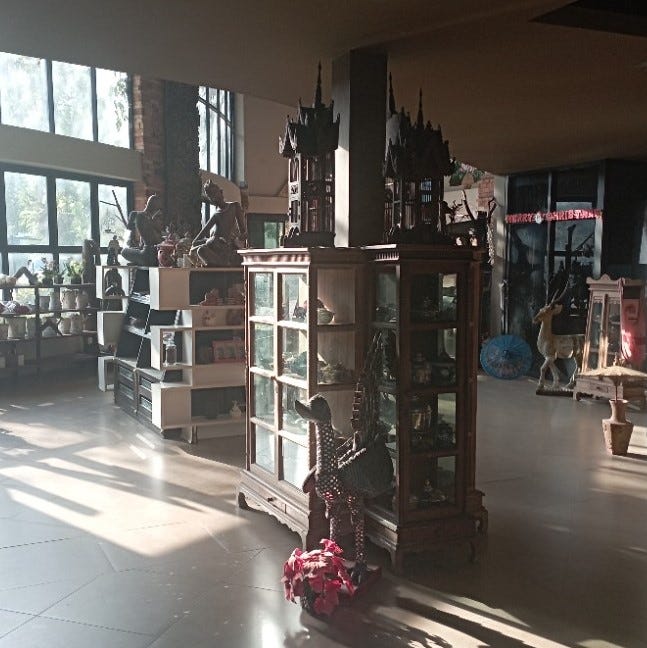
I think most council parks and gardens are still maintained by council staff although maybe some are supplemented by volunteers - perhaps Singleton Park is, despite being council run? Kew is still definitely run by paid staff, although they now do have some volunteers too, which they never did when I worked there. It may be a slippery slope, but I am sure that it would never mean the end of paid horticultural work at Kew or other botanic gardens, as much of the work is so specialised.
Another wonderful read! But how unexpected to be reminded of the awful Noel Edmonds in the strange botanical gardens of Phuket, love the photos!